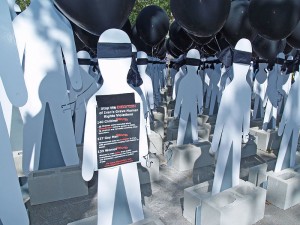“Religion Strikes Again: Medieval Savagery In Iran”
The Polemicist
by Michael House
LONDON, England—(Weekly Hubris)—7/19/10—What follows is a story of medieval, religion-fuelled brutality, almost unbelievable in the 21st century.
Sakineh Mohammadi Astiani is a 43-year-old Iranian woman. She was convicted in one of the country’s kangaroo courts of adultery. She has spent 5 years in prison and received 99 lashes, and the authorities now want to stone her to death. Her son, Sajad Ghadarzade, 22, has risked his liberty and, possibly, his life, by alerting human rights campaigners to his mother’s fate.
The religio-criminal gang that rules Iran has reacted in characteristic fashion, claiming that there was never any intention of judicially murdering Ms. Astiani, and that it was all a Western plot to discredit the regime—as if the regime needed any help in that direction.
Between 1986 and 1997, it is estimated that at least 50 women were stoned to death in Iran. Amnesty International states that between 2006 and 2008, five people were stoned to death. Two men suffered this fate last December, and at least 10 Iranians are on death row awaiting their fate.
The judiciary declared a moratorium on stoning in 2002, presumably to appease world opinion. But the moratorium is a sham.
Stoning is not referred to in the Koran. It was introduced into the penal code after the Khomenei revolution. Article 83 states that stoning is the penalty for married men and women who commit adultery. Article 102 states that men shall first be buried up to their waists and women up to their breasts. Article 104 deals with the size of stones to be used. They should be “not large enough to kill the person by one or two strikes; nor should they be so small that they cannot be called a stone.” In other words, death must be inevitable, but a quick death must be avoided.
Iran makes Texas and Utah seem positively civilized.
To be fair, there is a clause that shows Islam’s essential humanity. Article 90 states that men and women who manage to free themselves and run away are to be pardoned, presumably because it is not the will of god that they should die. How people buried in a hole in the ground, swathed in bandages from head to foot, and surrounded by men hurling rocks at them can free themselves and run away is not clear.
There is in existence a video dating from 1994, which shows Iranian justice in action. A warning precedes the execution: “The scenes are gruesome and not easy to watch.” It shows a man, bandaged from top to toe, being carried to a hole in the ground, and buried alive as the mob bays for gore. The crowd then forms a ring around him and hurls rocks at him until he is dead, his bandages dripping with blood.
Stonings take place in public, usually with about 20 men participating. The judge and the witnesses throw the first stone, from about 10 yards. Relatives are often forced to watch. It takes up to half an hour for a victim to die.
As usual in Islam, it is women who are the main victims. They have usually been forced into marriage. They are bound by fidelity, while men may take up to four wives. Their court testimony is governed by the rule that the evidence of a woman is worth only half that of a man. The judges are invariably men. Women are buried more deeply than men, so it is harder for them to escape, especially when swathed in bandages.
I can hardly believe I am writing this in 2010.
Legal representation is rudimentary in Iran, but tribute should be paid to Ms. Ashtiani’s lawyer, Mohammed Mostafaei, who has fought tooth and nail for justice. The regime will doubtless target him in the future.
Iran is not alone. Other Islamic countries have carried out this practice. The Taliban practiced stoning in Afghanistan until the invasion in 2001.
In 2008, a 13-year-old girl was stoned to death in Somalia.
There have been isolated reports from Saudi Arabia and Nigeria.
But the Islamic Republic of Iran is the main perpetrator.
Is there any force in the world responsible for as much wickedness as religion?
In unrelated news: I understand that there is currently a shortage of aspirants to the Roman Catholic priesthood. In the past, young boys were eager to enter the priesthood. Now it is the other way round.


2 Comments
eboleman-herring
I had lunch with a Persian friend, H., today, a NJ businesswoman with US citizenship who, I believe, fled Iran so her daughters could have “modern” lives. She’s in agony about the fate of Sakineh, and tells me that the woman’s story would never have “got out” were it not for her son’s cell-phoning the story to the West. Now, the son, and Sakineh’s lawyer–plus the lawyer’s family, who are in custody–face prosecution as well. H. says Sakineh may escape stoning, but not execution. So it goes. In Iran. In Pakghanistan, in Saudi Arabia, in Somalia, etc. “Why is there a United Nations?” asks H. “Why did Bush and Cheney invade the wrong country?” And how can we, who are attempting to live in the 21st century, let our sisters endure medieval torture in another time zone? We ARE a failed species, Michael. Best, Elizabeth
eboleman-herring
The New York Times ran an excellent piece on stoning and Shariah law and Iran et al, today. You need to keep following this story, Michael, from the UK, where you get more real news on the Middle East than do we. I didn’t know till today that Sakineh’s charge has now been changed to “murder,” a lesser crime, I guess, in uber-patriarchal Iran. Apparently, the Taliban in Afghanistan still hold the record on recent stonings of women, though.